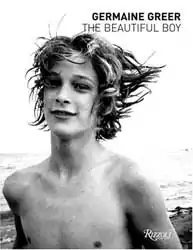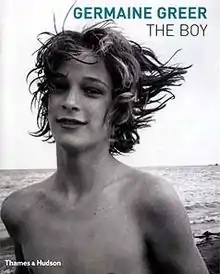The Beautiful Boy
The Beautiful Boy (or just The Boy[1]) is a book by Germaine Greer, published in 2003. Its avowed intention was "to advance women's reclamation of their capacity for and right to visual pleasure". It is a study of the youthful male face and form, from antiquity to the present day, from paintings and drawings to statuary and photographs.
 Cover of The Beautiful Boy, showing Björn Andrésen in 1970 by David Bailey | |
| Author | Germaine Greer |
|---|---|
| Language | English |
| Subject | Art history |
| Published | 2003 |
| Publisher | Rizzoli |
| Pages | 256 pp |
| ISBN | 0-8478-2586-8 |

The cover picture caused minor controversy when the subject of the photograph, Björn Andrésen, a Swedish actor and musician who played Tadzio in Death in Venice (billed by the director Luchino Visconti as "the most beautiful boy in the world") stated in the press that he objected to the picture having been used without his permission.[2][3]
The book contains some 200 pictures of boys through the ages, and is a history of boys in art. Pictures and discussions range from Cupid to Elvis, Boy George, Kurt Cobain, and Jim Morrison.
Greer has described the book as "full of pictures of 'ravishing' pre-adult boys with hairless chests, wide-apart legs and slim waists". She goes on to say that, "I know that the only people who are supposed to like looking at pictures of boys are a subgroup of gay men," she wrote in London's Daily Telegraph. "Well, I'd like to reclaim for women the right to appreciate the short-lived beauty of boys, real boys, not simpering 30-year-olds with shaved chests."[4] She was criticized for these comments with some writers labeling her a paedophile.[5]
Germaine Greer responded vigorously on Andrew Denton's television talk show Enough Rope.[6]
See also
- The Most Beautiful Boy in the World – 2021 documentary film about Björn Andrésen
Notes
- Depending upon the edition the cover shows the title to be "The Boy" or "The Beautiful Boy", as do booksellers
- 'The Guardian:' comments following use of Andrésen's picture on the cover of "The Boy"
- 'Fairfax Digital:' "I'm not Greer's play toy"
- Devine, Miranda (2003-07-10). "Generation of taboo breakers are a selfish lot". The Sydney Morning Herald. Retrieved 2007-09-09.
She wouldn't say exactly how young the "boys" are in her book but has cheerily admitted it will "get me into a lot of trouble" and expects she will be called a pedophile.
- Young, Emma (2003-10-23). "Sticks and stones may break bones but not stereotypes". The Sydney Morning Herald. Retrieved 2007-09-09.
The knee-jerk response to an older woman writing of her appreciation of semi-naked boys has elicited accusations of pedophilia. The delayed response should be a more mild questioning of why a woman who has passionately railed against the exploitation of the female body has identified the reversal of the gender roles in this same scenario of objectification as feminist.
- Andrew Denton (2003-09-15). "Enough Rope". ABC TV. Retrieved 2008-02-09.
Andrew Denton: There are those who say — have already said in print — that what you're doing is creepy. It's no different to an old man staring at a young girl and lusting after them.
Germaine Greer: (CHUCKLES) Well, you can't stop the old man staring at the young girl and lusting. What are you going to do — tell old men that they must be blindfold or something? I don't think that's particularly creepy as long as they understand that they're not…they have no right to lay hands on that person. But you can't stop them. How could you? I mean, the luminous figure of a beautiful young girl walking down the street and the old men sitting on the wall, leaning on their sticks. What are you going to say? "Look the other way, you dreadful old bastards"? What are you going to say? It's part of the joy of life is admiring the beauty of things that are beautiful. What is important to me about the Boy is that once upon a time his beauty was understood and celebrated by people of both sexes. A boy was allowed to dress in very bright colours, he was allowed to show himself off in the street, he dyed his hair, he wore make-up, he wore a little cap tipped over his eye with a big feather in, he wore tight pants and cropped jackets and so on. And the girls looked down from behind their jalousie and talked about the best-looking boys.